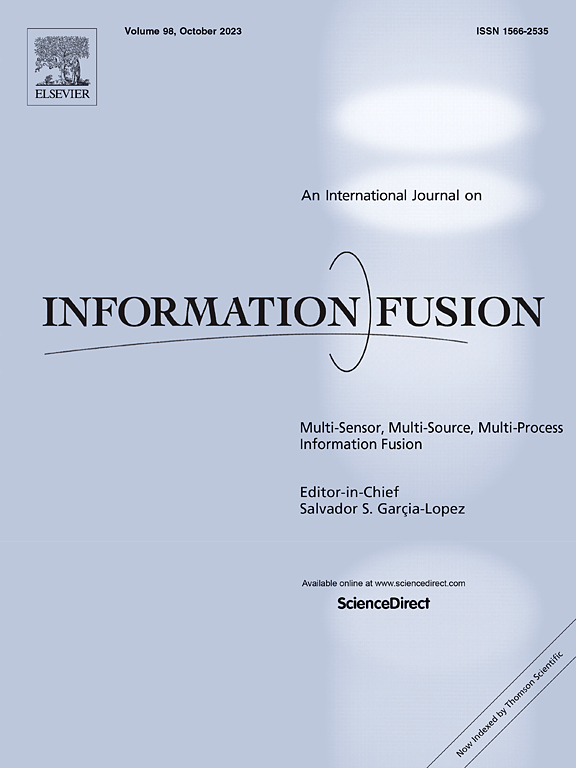FusionSegNet:一种分层多轴关注和门控特征融合网络,用于超声成像中不确定性建模的乳腺病变分割
IF 15.5
1区 计算机科学
Q1 COMPUTER SCIENCE, ARTIFICIAL INTELLIGENCE
引用次数: 0
摘要
乳腺超声图像(BUS)中的病灶分割由于噪声、低对比度外观、模糊边界、纹理不一致和病灶外观固有的不确定性而具有挑战性。在基于u - net的模型中,编码器和解码器特征之间的语义差距进一步加剧了这些挑战。在本文中,我们介绍了一种新的病变分割网络FusionSegNet,它集成了几个关键的创新来解决这些挑战。首先,我们提出了一个基于模糊逻辑的多尺度上下文网络作为编码器,通过多尺度关注和基于模糊隶属度的不确定性估计来处理噪声和不确定区域。其次,设计加权乘法融合模块,在抑制噪声的同时有效融合多尺度特征。第三,我们在编码器和解码器中集成了分层多轴注意力,以增强跨多个维度的焦点,使FusionSegNet能够更好地分割具有不同位置,scalesscalessizesd大小的目标。第四,我们引入了一个门控的多尺度特征聚合模块,它将局部和全局信息连接起来,以更好地理解语义;新集成的亚特鲁斯注意力融合模块使用不同的膨胀率进一步细化多尺度远程上下文细节。最后,我们设计了一个门控多尺度融合块,促进了编码器和解码器之间的特征融合,以保持空间一致性。广泛的实验和对两个基准总线数据集的综合烧消研究验证了FusionSegNet及其集成设计选择优于最先进方法的优势。FusionSegNet在UDIAT数据集上实现了93.22%的mDSC,在BUSI数据集上实现了80.10%的mIoU,为BUS图像的病灶分割建立了新的基准。我们的代码可以在https://github.com/simanto99/FusionSegNet上找到。本文章由计算机程序翻译,如有差异,请以英文原文为准。
FusionSegNet: A Hierarchical Multi-Axis Attention and gated feature fusion network for breast lesion segmentation with uncertainty modeling in ultrasound imaging
Lesion segmentation in breast ultrasound images (BUS) is challenging due to noise, low contrast appearance, ambiguous boundaries, texture inconsistencies, and inherent uncertainty in lesion appearance. These challenges are further exacerbated by the semantic gap between encoder and decoder features in U-Net-based models. In this paper, we introduce FusionSegNet, a novel lesion segmentation network that integrates several key innovations to address these challenges. First, we propose a Fuzzy Logic-Based Multi-Scale Contextual Network as the encoder to handle noisy and uncertain areas through multi-scale attention and fuzzy membership-based uncertainty estimation. Second, we design a Weighted Multiplicative Fusion Module to effectively merge multi-scale features while suppressing noise. Third, we integrate Hierarchical Multi-Axis Attention in both the encoder and decoder to enhance focus across multiple dimensions, enabling FusionSegNet to better segment targets with varypositions, scalesscalessizesd sizes. Fourth, we introduce a Gated Multi-Scale Feature Aggregation Module that bridges both local and global information for better semantic understanding, and the newly integrated Atrous Attention Fusion Module further refines multi-scale long-range contextual details using different dilation rates. Finally, we design a Gated Multi-Scale Fusion Block which facilitates feature fusion between the encoder and decoder to maintain spatial consistency. Extensive experiments and a comprehensive ablation study on two benchmark BUS datasets validate the superiority of FusionSegNet and its integrated design choices over state-of-the-art methods. FusionSegNet achieves an mDSC of 93.22% on the UDIAT dataset and an mIoU of 80.10% on the BUSI dataset, establishing a new benchmark for lesion segmentation in BUS images. Our code can be found at https://github.com/rayhan-ahmed91/FusionSegNet.
求助全文
通过发布文献求助,成功后即可免费获取论文全文。
去求助
来源期刊

Information Fusion
工程技术-计算机:理论方法
CiteScore
33.20
自引率
4.30%
发文量
161
审稿时长
7.9 months
期刊介绍:
Information Fusion serves as a central platform for showcasing advancements in multi-sensor, multi-source, multi-process information fusion, fostering collaboration among diverse disciplines driving its progress. It is the leading outlet for sharing research and development in this field, focusing on architectures, algorithms, and applications. Papers dealing with fundamental theoretical analyses as well as those demonstrating their application to real-world problems will be welcome.
 求助内容:
求助内容: 应助结果提醒方式:
应助结果提醒方式:


